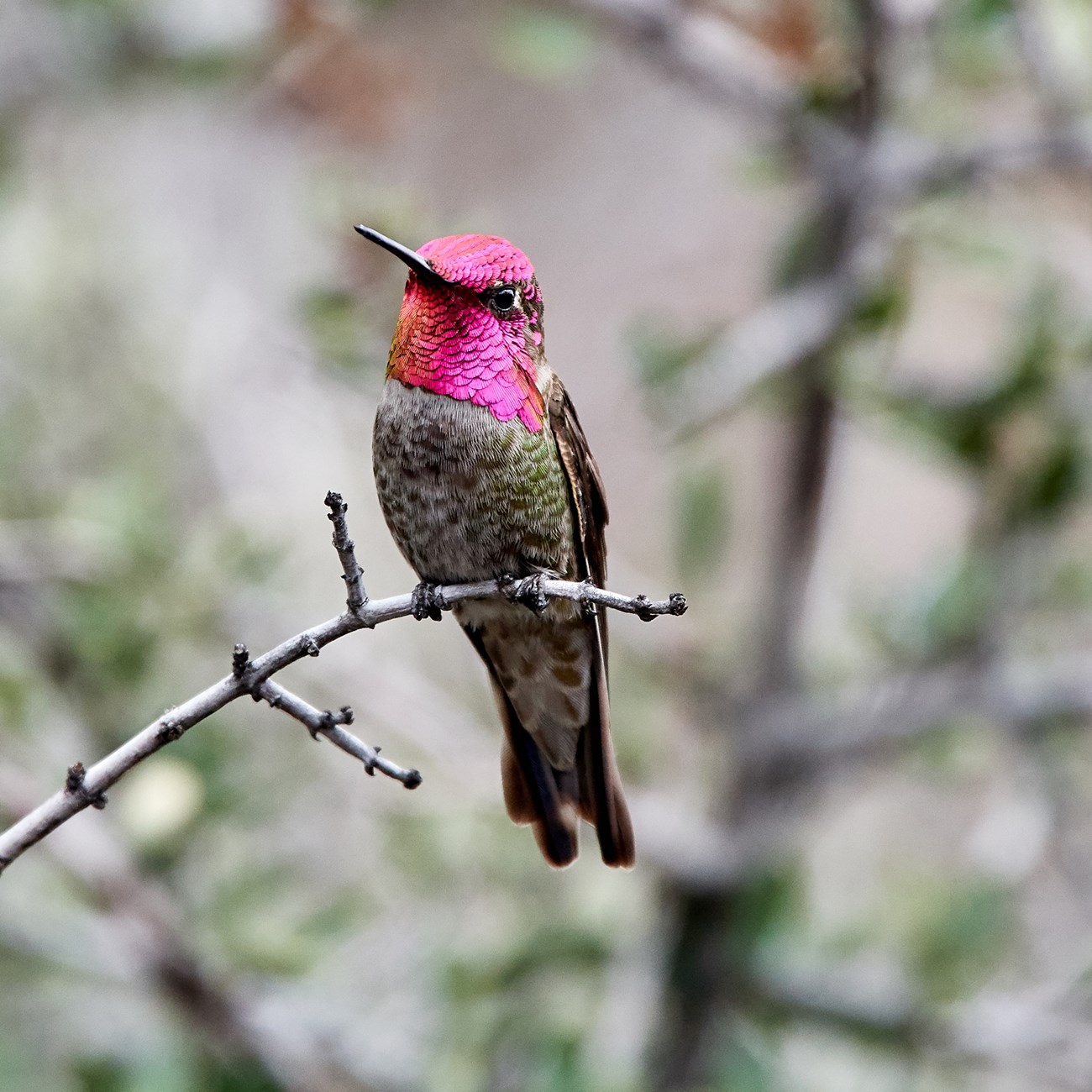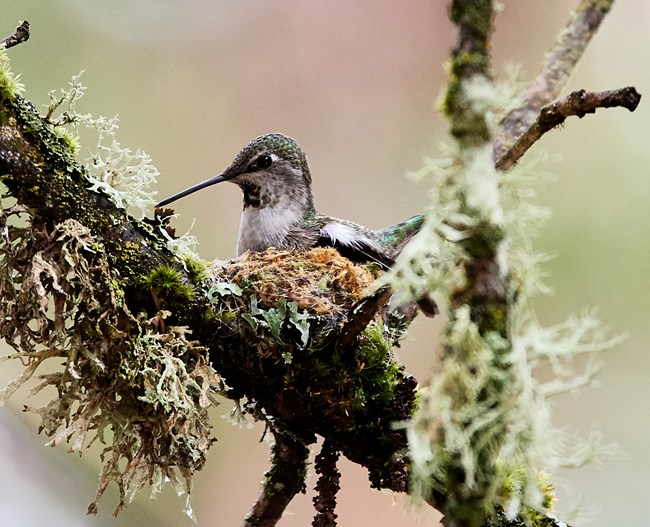Last updated: May 20, 2025
Article
Anna's Hummingbird

©Frank Lospalluto
General Description
In the dead of a Pacific Northwest winter, the last sound you’d expect to hear is the buzzy static of a hummingbird zipping through the canopy. But the resourceful Anna’s hummingbird can be found year-round up and down the West Coast, surprising us with its loud, flashy presence.
The hummingbird family, Trochilidae, has over 300 species, all native to the Americas, with most in South America. The Anna’s hummingbird, Calypte anna, is a medium to large hummingbird (10 cm; 4 in) that weighs about 2 pennies (4–4.5 g). Its body is greenish-bronze above and grayish-white below. The male’s throat flashes an iridescent rose gorget, and unlike other North American hummingbirds, this rose iridescence also covers his crown. Females may have just a few streaks of throat color.
Habitat and Distribution
Since the 1960s, a dramatic range expansion brought Anna’s hummingbirds northward and eastward from their historical habitat in southern California chaparral. This coincided with the spread of 3 new food sources: winter-blooming Eucalyptus trees, a growing buffet of exotic blooms in urban gardens, and ubiquitous hummingbird feeders. These factors may also help explain this species’ unusual ability to overwinter in relatively cold climates, although it is not clear whether wintering birds are local breeders or migrants from elsewhere.
Behavior and Feeding
Anna’s hummingbirds are not very social, aggressively defending territories and frequently conflicting with each other. Males and females only come together to copulate.
The Anna’s hummingbird feeds primarily on nectar from a wide variety of plants, especially currant and gooseberry (Ribes spp.), flicking its double grooved tongue repeatedly into a flower, retracting it, and then extending it again with slightly closed bill to strain the nectar into the mouth. Like other pollinators, the hummingbird does double duty as it drinks nectar, spreading the pollen dusting its face and bill to other flowers. It also eats small insects and spiders, and occasionally sap.
Hummingbirds have very high metabolisms, with resting heart rates of 420–460 beats/minute that can jump to 1220 in flight! Average body temperatures are 40°C (107°F). So how does a very small bird with a high metabolism survive cold winters? Obviously steady fuel is key, but so is torpor—a lowering of metabolism on cold days and at night. In hummingbird torpor, breathing can be suspended for minutes, heart rate can dip to 50 beats/ minute, oxygen consumption slows, and body temperature can cool dramatically (one was documented at 8.8°C; 48°F). A torpid hummingbird will be inactive, with feathers fluffed and eyes closed—do not disturb!
Males sing a complex, buzzy 3-part song they first learn by imitating adults. As they sing, they flash their rose gorget from side to side. Males may sing at any time of the year and both sexes make buzzy calls.

©Frank Lospalluto
Reproduction
Anna’s hummingbirds breed earlier than other species, typically Dec–May. The male makes dramatic courtship dives, rising ~35 m (114 ft) and plunging down in a J-shaped pattern that ends with a tail “bark.” After copulation, the female assumes all nesting duties. On a suitable tree branch, she builds a walnut-sized cup nest made from downy plant material and small feathers, glued together by spider webs. Her 2 white, oval, jelly-bean-sized eggs hatch in 14–19 days. The young fledge in 20–30 days. This species typically raises 2+ clutches per season.
Fun Facts
- Iridescence on birds comes from the way light is refracted like a prism by its feather structure, not from pigment.
- Hummingbird wings beat from 12 to 80 times/sec, depending on species, and move in a figure 8 motion, allowing for hovering and backwards flight.
- The Anna’s hummingbird was named after the Duchess of Rivoli, Anna de Belle Massena.
Conservation
With populations expanding to exploit human-provided food sources, this species is not a conservation concern.
Where to See
Anna’s hummingbirds are present in all Klamath Network parks, and commonly breed in Redwood NSP, Whiskeytown NRA, and Lava Beds NM.
More Information
https://www.birdwatchingdaily.com/news/species-profiles/annas-hummingbird-our-winter-hummingbird/
https://www.allaboutbirds.org/guide/Annas_ Hummingbird/sounds
Download a pdf of this article.
Prepared by Sonya Daw
NPS Klamath Inventory & Monitoring Network
Southern Oregon University
1250 Siskiyou Blvd
Ashland, OR 97520
Featured Creature Edition: April 2019
Thumbnail image credit: Frank Lospalluto
